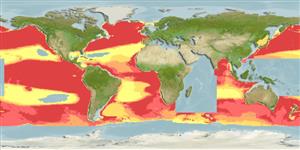>
Gadiformes (Cods) >
Macrouridae (Grenadiers or rattails)
Etymology: Coryphaenoides: Greek, koryphaina = dolphin fish + Suffix oides = similar to (Ref. 45335); armatus: From 'cyklos' meaning circle and 'lepis' meaning scale (Ref. 6885).
Environment: milieu / climate zone / depth range / distribution range
Ecologia
marinhas batipelágico; intervalo de profundidade 282 - 5180 m (Ref. 50610). Deep-water; 65°N - 61°S, 180°W - 180°E (Ref. 1371)
Worldwide: marginal to the Southern Ocean (Ref. 5171).
Tamanho / Peso / Idade
Maturity: Lm ? range ? - ? cm
Max length : 102 cm TL macho/indeterminado; (Ref. 1371)
Espinhos dorsais (total) : 2; Raios dorsais (total) : 123 - 124; Espinhos anais: 0; Raios anais : 115. The head is large; the eyes also large. The snout is elongated, somewhat conical; the mouth is small and inferior. The body tapers from behind the first dorsal fin. The light organ extends past midway between the anal origin and the ventral insertion. Color is uniformly brownish, except for the abdomen which is bluish.
A deep-slope upper continental rise species, common in deep waters of most oceans (Ref. 1371). Bathypelagic (Ref. 58426). Feeds on a variety of benthic invertebrates (especially crustaceans and holothuroids) when young, switching to primarily mesopelagic and bathypelagic fish, and sea urchins and cephalopods as adults (Ref. 1371). Sex ratio was 2.6:1 male to female (n = 449) in the Rockall Tough, N.E. Atlantic (Ref. 40742).
Ciclo de vida ou comportamento de acasalamento
Maturities | Reprodução | Spawnings | Egg(s) | Fecundities | Larvas
Cohen, D.M., T. Inada, T. Iwamoto and N. Scialabba, 1990. FAO species catalogue. Vol. 10. Gadiform fishes of the world (Order Gadiformes). An annotated and illustrated catalogue of cods, hakes, grenadiers and other gadiform fishes known to date. FAO Fish. Synop. 125(10). Rome: FAO. 442 p. (Ref. 1371)
Status na Lista Vermelha da UICN (Ref. 130435)
Ameaça para os humanos
Harmless
Uso pelos humanos
Pescarias: sem interesse
Ferramentas
Relatórios especiais
Baixar XML
Fontes da internet
Estimates based on models
Preferred temperature (Ref.
123201): 1.9 - 5.1, mean 3.3 °C (based on 3307 cells).
Índice de diversidade filogenética (Ref.
82804): PD
50 = 0.5000 [Uniqueness, from 0.5 = low to 2.0 = high].
Bayesian length-weight: a=0.00219 (0.00111 - 0.00431), b=3.20 (3.03 - 3.37), in cm total length, based on LWR estimates for this (Sub)family-body shape (Ref.
93245).
Nível Trófico (Ref.
69278): 3.6 ±0.52 se; based on food items.
Resiliência (Ref.
120179): Muito baixo(a), tempo mínimo de duplicação da população maior que 14 anos (Preliminary K or Fecundity.).
Fishing Vulnerability (Ref.
59153): High vulnerability (61 of 100).
